|
|
|
Sort Order |
|
|
|
Items / Page
|
|
|
|
|
|
|
| Srl | Item |
| 1 |
ID:
127334
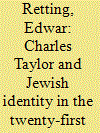

|
|
|
|
|
| Publication |
2013.
|
| Summary/Abstract |
The Jewish world is losing its ability to discuss its cultural differences. Our intra-Jewish dialogue is becoming less coherent. Indeed, the very ideas underlying our Jewish identities, ideas shaped by our language of values, are diverging. The language we use to describe our values is becoming more specific to the respective Jewish communities to which we belong, in Israel and in the Diaspora. We could be heading for a crisis.
|
|
|
|
|
|
|
|
|
|
|
|
|
|
|
|
| 2 |
ID:
127336
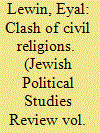

|
|
|
|
|
| Publication |
2013.
|
| Summary/Abstract |
Almost thirty-five years after Camp David and twenty years after the Oslo Accord, a fundamental question remains unanswered: does the majority of the Israeli public support a left-wing or right-wing ideology? The answer, in a democratic system, should be obvious, since elections are supposed to give a clear picture of the political preferences of the voting public. However, Israeli polls are misleading. After the Yom Kippur disaster in 1977, Menachem Begin won his premiership running as the hawkish leader who never would surrender even one grain of sand from the Land of Israel. Yet after he personally gave up the entire Sinai Peninsula his party won an even greater majority in 1981.1 Yitzhak Rabin won his premiership in 1992 representing the hawkish section of the Labor party with declarations that he would never negotiate with the PLO;2 yet it seems that signing the Oslo Accords led him, rather, to the peak of his popularit.
|
|
|
|
|
|
|
|
|
|
|
|
|
|
|
|
| 3 |
ID:
133308
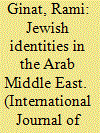

|
|
|
|
|
| Publication |
2014.
|
| Summary/Abstract |
Much work has been done in recent decades on the histories of the Jews of Arab lands across a variety of time periods, reflecting an increasing interest in the historical past of the Jews of the "Orient." While diverse, this literature may be divided into several general groups. The first comprises studies written by Western and Israeli scholars and encompasses a broad spectrum of Arabic-speaking countries. This literature has explored, among other things, issues relating to the way of life and administration of ethnically and culturally diverse Jewish communities, their approaches to Zionism and the question of their national identities, their positions regarding the Zionist-Israeli-Arab conflict in its various phases, and the phenomena of anti-Semitism, particularly in light of the increasing escalation of the conflict. It includes works by Israeli intellectuals of Mizrahi heritage, some of whom came together in the late 1990s in a sociopolitical dissident movement known as the Mizrahi Democratic Rainbow Coalition. The target audience of this movement was Mizrahi Jews: refugees and emigrants from Arab countries as well as their second- and third-generation offspring. The movement, which was not ideologically homogeneous (particularly regarding approaches to the resolution of the Israeli-Palestinian conflict), took a postcolonialist approach to the Zionist narrative and enterprise, and was critical of the entrenchment of the Ashkenazi (European-extraction) Jews among the elites of the emerging Israeli society. The movement had scant success in reaching its target population: the majority of Mizrahi/Sephardi Jews living in Israel. Nevertheless, it brought to the fore the historical socioeconomic injustices that many Jews from Arab countries had experienced since arriving in Israel, whether reluctantly or acquiescently.
|
|
|
|
|
|
|
|
|
|
|
|
|
|
|
|
| 4 |
ID:
133303
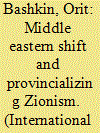

|
|
|
|
|
| Publication |
2014.
|
| Summary/Abstract |
Scholars working on Jewish communities in the Middle East are in the midst of an important historiographical moment, in which the major categories, historical narratives, and key assumptions within the field are undergoing radical changes. A cluster of books and articles written by scholars trained in history, anthropology, and area studies departments, and published in Middle East studies rather than Jewish studies book series and journals, suggests that the study of Middle Eastern Jewish communities in the American academy is undergoing a change which might be termed "the Middle Eastern turn." For such scholars, the history of Jews in Muslim lands, as modern subjects and citizens, is typified by a multiplicity of categories related to their identities-Ottoman, Sephardi, Mizrahi, Arab-Jewish, and local-patriotic-which they explore by looking at the political organizations and social and cultural institutions that enabled the integration of modern Jews into new imperial and national frameworks. This new scholarly wave is transnational, as it illustrates the importance of Jewish networks and Jewish languages in the Middle East, and likewise seeks to draw comparisons between Jews and other transregional and religious minorities, such as Armenians and Greek Orthodox Christians. It is interdisciplinary, as it attempts to incorporate the insights of sociologists, anthropologists, and literary scholars. Finally, it is postcolonial, in its critiques of national elites, national narratives, and nationalist histories. These new accounts uncover how processes which affected the entire Middle East, like Ottoman and Egyptian reform politics and the rise of nation-states, shaped modern Jewish lives.
|
|
|
|
|
|
|
|
|
|
|
|
|
|
|
|
| 5 |
ID:
112532
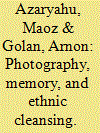

|
|
|
|
|
| Publication |
2012.
|
| Summary/Abstract |
Much of the recent academic literature on the 1948 war portray it a one-sided-and thus simplistic-ethnic cleansing of the Arab population of Palestine. Referred to as the Naqba paradigm, it features the Jews/Zionists as villainous perpetrators and the Palestinian Arabs as feeble victims. Accordingly, the story of "the 1948 Ethnic Cleansing of Palestine" excludes expulsion and massacres of Jews, the destruction of Jewish communities, and the erasure of the Jewish signifiers in the local landscape from the story. As made explicit in John Phillips' photo-reportage featuring the destruction of the Jewish Quarter of the Old City of Jerusalem, the ethnic cleansing of Palestine also involved the expulsion of Jews and the destruction of their communities-whenever and wherever military power relations were in favor of Arab forces.
|
|
|
|
|
|
|
|
|
|
|
|
|
|
|
|
| 6 |
ID:
124351
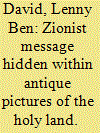

|
|
|
|
|
| Publication |
2012.
|
| Summary/Abstract |
A 110-year-old trove of pictures taken by the Christian photographers of the American Colony in Jerusalem provides dramatic proof of thriving Jewish communities in Palestine. Hundreds of pictures show the ancient Jewish community of Jerusalem's Old City and the Jewish pioneers and builders of new towns and settlements in the Galilee and along the Mediterranean coastline. The American Colony photographers recorded Jewish holy sites, holiday scenes and customs, and they had a special reason for focusing their lenses on Yemenite Jews.
|
|
|
|
|
|
|
|
|
|
|
|
|
|
|
|
|
|
|
|
|